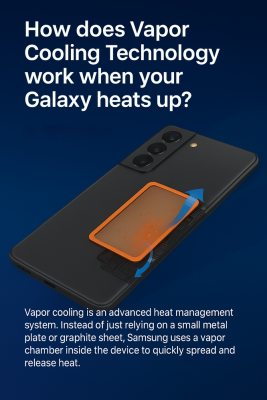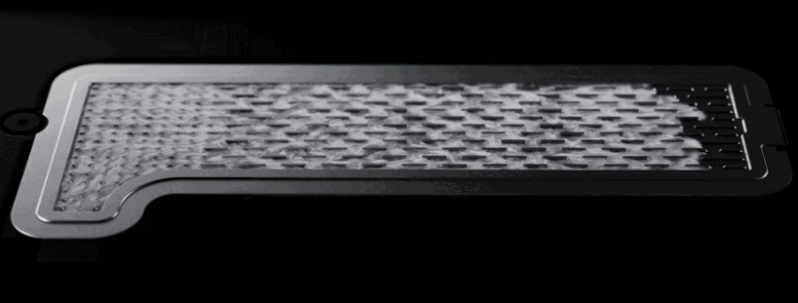Once upon a time, home computers were low-powered enough that they barely needed any cooling at all. An Amiga 500 didn’t even have a heatsink on the CPU, while the early Macintosh got by with a single teeny little fan.
Modern smartphones are far more powerful than these ancient machines, packed with multi-core processors running at speeds of many gigahertz. Even still, they’ve generally been able to get by without any active cooling devices. However, as manufacturers continue to push the envelope of performance, they’ve had to scramble for ways to suck heat out of these handheld computers. Vapor chamber cooling has risen as a solution to this problem, using simple physics to keep your handset humming along at maximum speed for longer.
Cool Runnings
Keeping a smartphone cool is a unique challenge compared to other computing devices. In a desktop or laptop computer, designers can rely on fans, heatsinks, and even water cooling loops with radiators to get heat out of a device. However, for a phone, these methods aren’t so practical. Any air vents would be quickly blocked by pocket lint, and even the slimmest fan or heatsink would add a huge amount of bulk, which is unacceptable for a handheld device.

Thus far, smartphones have largely avoided heating issues in two ways. Firstly, by using low-power chipsets that simply don’t generate a lot of heat in the first place. Secondly, by thermally coupling the main chips to metal heat spreaders and sometimes the smartphone’s external housing, to effectively create a simple heatsink. However, smartphones continue to grow more powerful, generating more heat during demanding tasks like recording high-resolution video. Thus, engineers have had to find new ways to dump greater amounts of heat without compromising the aesthetics and usability of their devices.
Enter vapor chamber cooling. Picture a sealed metal cavity built into a smartphone, inside which is a small amount of water-based coolant. The phone’s chipset is thermally coupled to the cavity, such that the heat is absorbed by the coolant inside. Thanks to the physical properties of water, notably its huge specific heat value, it’s able to absorb a great deal of heat energy, particularly as it passes through the phase-change regime as the fluid turns from a liquid into a gas. As it heats up and vaporizes, the coolant spreads to fill the entire cavity, spreading the heat into the whole thermal mass of the casing where it can be released into the surroundings. As heat is released, the vapor cools back into a liquid, and the cycle can begin again. The idea is exactly the same as is used in heat pipes—where a liquid is heated beyond its phase change point into a vapor, and used to spread heat to other areas of a sealed cavity.

The vapor chamber has benefits over traditional metal heatsinks. The liquid coolant is very effective at evaporating and spreading heat around the entire chamber, wicking heat away from hot chips more quickly. Traditional heatsinks can end up with a hotspot over individual chips, whereas the vapor chamber is more effective at distributing the heat over a wider area.
The intention behind this is to allow phones to run at maximum performance for longer. Whether you’re shooting video or playing a game, it’s no good if your phone has to start throttling clock rates to stay cool in the middle of a task. The vapor chamber simply helps engineers suck more heat out of a phone’s chipset and get rid of it faster.

One drawback is that vapor chambers are obviously far more complex to manufacture than traditional heatsinks. Rather than a flat metal heat spreader, you have a delicate chamber into which coolant must be injected, and then the chamber must be sealed. The coolant must be able to soak up a great deal of heat, as well as safely deal with many cycles of vaporization and condensation, without causing any corrosion or damage to the chamber in the process. The entire vapor chamber must be able to survive the rough-and-tumble life of a handheld device that’s stuffed into pockets and thrown into bags every day of its life.
Vapor chambers have been around for a while now, first showing up in the Galaxy S7 in 2016. They’ve gradually become more popular, though, and these days, you’ll find a vapor chamber in phones like the Google Pixel 9 Pro, the Samsung Galaxy S25+, and the Apple iPhone 17 Pro and Pro Max. They’re still largely the preserve of flagship devices, perhaps as much due to their high-tech appeal and higher cost than traditional cooling solutions. Still, as the smartphone arms race continues, and these parts become more common, expect the technology to trickle down to more humble models in the years to come.
















The earliest Macintosh had no fan: Macintosh 128K Teardown
Neither did the DEC VAXmate.
But they both needed one.
At least the Mac had an aftermarket supply for them. The DECs? They just died quickly.
Look up “MacChimney for a bizarre attempt to help the cooling of classic Macs by fitting a, well, chimney to the top!
In the initial design, Steve Jobs was adamant that the Mac have no fan. Ironically, one thing they did to help design the Mac (including computational fluid dynamics for the Mac case) was install a series of Cray supercomputers with massive cooling towers.
https://cray-history.net/2021/07/16/apple-computer-and-cray-research-some-notes/
Hmm wouldn’t vapour chambers make a lot of sense for desktop computers? I mean it will move away more heat than traditional aluminium heatsinks while also being far more reliable than enthusiast grade liquid cooled setups with pumps and radiators
and
I think heatpipe coolers have been completely normal in computers for at least 20 years now.
https://en.wikipedia.org/wiki/Heat_pipe?useskin=vector#Computer_systems
ooops its more like 30 years.
I wonder why they don’t just call it a heat pipe. It is a heat pipe.
i’m not 100% sure because i’ve never opened one up to let the vapor out, but i think something similar has been the norm for PC laptops for at least 20 years. in that context, they’re called “heat pipes”. on a desktop, there just isn’t the size limitation so mostly you can get by with separate big honkin heatsinks and fans directly on top of the CPU and GPU. i don’t know about the context where you need a bigger heatsink than that, though a quick google shows you can buy heatsinks with heat pipes within them that look appropiate for a desktop PC
A lot of desktop pee cees, or more properly workstations have heat pipe based coolers. You can see the heat pipe comes up from the plate the contacts the actual CPU and the fins are actually connected to the heat pipes. They usually have more than one. I have seen this type of cooling system mostly in higher end workstations with CPU’s that are expected to run hot.
The original AMD Wraith cooler had heatpipes and was bundled with the FX-8350.
So, it’s just a flat and wide heat pipe? Everything old is new again, if marketing can come up with a new name.
They are significantly different in detail; heat pipes are optimized to move heat “away from the hot end”, often a long way away. They’re often structured to significantly bias heat travel from the (design) hot end to the (design) cold end, and often intentionally as well as inherently work poorly in the other direction.
Those rooftop solar water heaters make effective use of this.
Vapor chambers are optimized for a different thing. They are an approximation of a heatsink made with much higher specific heat capacity (warms fewer degrees for the same number of watts) but also much lower thermal resistance (heat applied at one spot more rapidly moves to other spot, eavening out any hotspots).
Metal heat sinks can have one or the other of these properties, but not both. High specific heat capacity is critical for bursty heat producers (like CCX subchips and many multicore designs), because even copper’s thermal resistance often isn’t low enough to move the heat away from the chiplet fast enough to keep it from spiking and throttling. At the same time, simple high specific heat capcity makes for a heat sink that warms up slower (preserving its ability to cool a chip longer), but also cools down slowly (loses heat slower, eventually limiting how much heat it can absorb).
Practical cooling for a load that is bursty and cycles over several orders of magnitude of heat production really calls for both capabilities at the same time. Thus, vapor chambers.
It all makes sense to an engineer, not just a marketer :D
It’s not a significant difference in detail. The operation is the same, only the shape is unconventional. There’s nothing saying a heat pipe can’t be “short and wide”.
I’d like to see a comparison between these flat heat-spreader chambers and that nifty graphite heat spreader material: That stuff has an in-plane thermal conductivity many times better than aluminum. (search for graphite in-plane heat transfer or spreader). They are kind of amazing at what they do. Magical alien technology as far as I can tell.
Graphite or graphene?
I found https://www.aliexpress.com/item/1005005916484901.html and also some vapor chambers on AE. So it would be possible to do one’s own testing. Interesting… so far I have not tried such things, but yes heat pipes have been used for a really long time already, and several generations of my desktop machines have had them.
Once I tried to build a mini-refrigerator by sandwiching a Peltier device between a heat-pipe CPU heatsink and a stainless steel tub (like the kind you would see at a salad bar in a restaurant typically). I never quite finished the project. It certainly moved some heat, but with enough insulation, would it stay cold enough? Maybe. I didn’t finish the door and seal, which would be important to keep the heat out.
Old laptops were already using heatpipes for a long time too. I did an experiment once: converted an old Thinkpad (from the trash at work) to a “server” by replacing the heat pipe and fan assembly with a passive deep-finned heatsink sticking out the back: I can stand it up vertically so the heat can escape better, but it’s not a comfortable laptop anymore. It was mostly pointless, because the laptop is so old that it doesn’t have a 64-bit CPU (Core architecture, the one before Core 2), so it’s hardly worth the power that it takes to run it; but it worked. (I still have it lying around, not sure what to do with it.) So I was actually kindof surprised to see flattened copper heatpipes in such an old one, but it makes sense: it certainly ran hot enough to need it.
I have an Acer Switch Black Edition tablet machine, which has a Core i7 processor, an nvidia GPU, is very thin and fanless. Yeah, they needed heat pipes to pull that off too: spread the heat out across the whole aluminum back side. (I’d never recommend Acer laptops, but at least this cooling system is cool, pun intended.)
Graphite. Two dimensional heat spreader. From reputable manufacturers.
The graphene-named ones are marketing-speak junk from fly-by-nighters.
Heat pipes and vapour chambers are likely much better. Heat pipes are said to reach up to 100,000 W/mk whereas the thermal conductivity of copper is only 400 W/mk. I couldn’t find any exact specs for graphite thermal pads but some sources claim as low as 13 W/mk or as high as 1500 W/mk. They are most often used in place of thermal paste where the conductivity can be even lower than 13 W/mk which makes the graphite a cleaner and more performant option.
I can’t see graphite replacing heat pipes though, their thermal conductivity is just so far beyond any solid materials due to the phase change.
hehe. ironically, there is a vaccine cooler available now called the Vaxmate.
Here I was thinking about Velocity of Propagation…
So the vapor spreads to all points of the “chamber”. Then what? Assuming it condenses how is the “liquid” put back in the bottle? Or the position in the chamber that it started in? My phone might be in my pocket, or on a table, or on a charging pad in my car, or on a holder in the car, or on a music stand, or google dock. And once we’ve heated the liquid up and it dissipates to all areas of the chamber then when we keep pumping heat in how do we continue to get rid of the new Heat coming in? Does the chamber have one-way valves?
the heat pipe version has a “wick” lining, so i guess condensate will naturally tend to distribute along the surface? i’m not sure but i think we’re looking at a context where surface tension might be more significant than gravity
Depending on phone orientation the hot end may be vertically above the cool end. A great deal of work went into designing the chamber. The type of fluid, its boiling point, amount, etc. condensed liquid in cool end would stay there when hot end is above it. A wick was designed capable of pumping fluid back to hot end quickly enough to cool hot end. Unlike heat sinks without liquid, the heat pipe temperature will be very uniform throughout whole chamber. Acceleration in a car or esp airplane can degrade wick performance depending on phone orientation.
It’s not a water based coolant – the liquid inside IS water. Just plain old deionized water. No special liquid. Heat pipes and such have tried but nothing works better or is cheaper.
And heat pipes conduct heat much faster than bulk copper which is why it’s used – Action Lab has a video showing how much faster a heat pipes conducts heat over plain copper.
It’s basically phase change – the water gets heated and turns into water vapor. The water vapor will naturally go to the colder end and condense back into water. A bit of fabric strung the entire length carries the water via capillary action back to the hot end.
Wow you’re right, he shows that it’s literally around 100x faster to use a heat pipe than solid copper! Very good video:
https://www.youtube.com/watch?v=OR8u__Hcb3k
https://undecidedmf.com/how-hydrogel-can-double-solar-panel-lifespan/
Make ’em sweat.